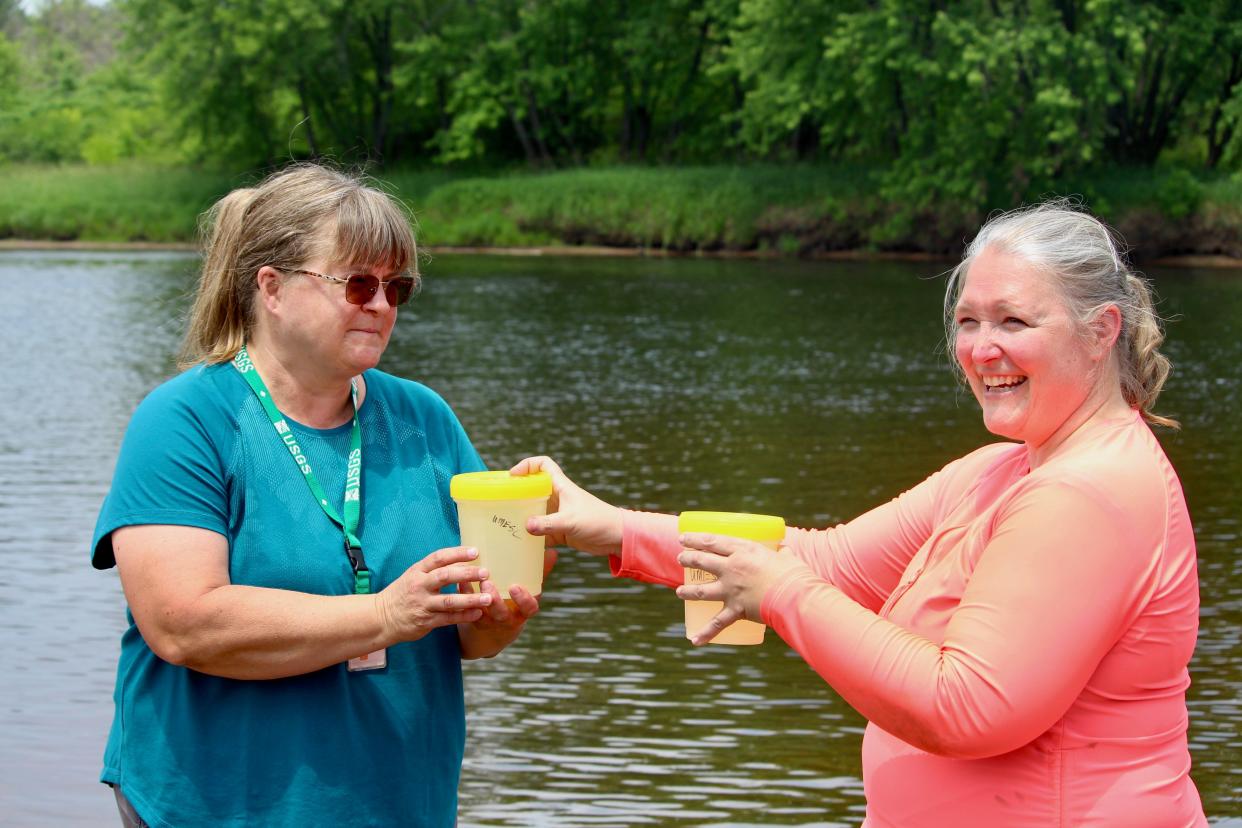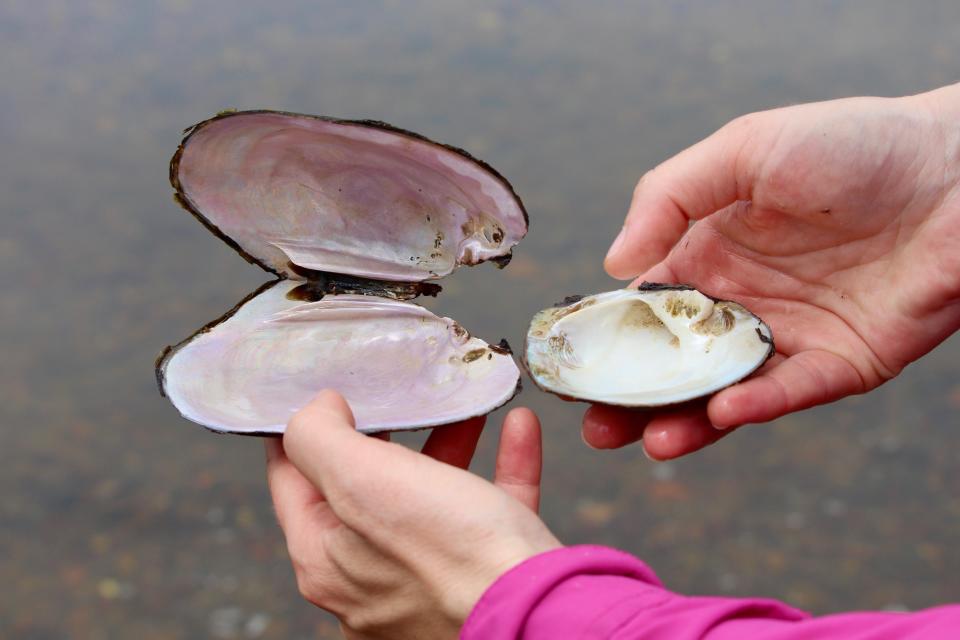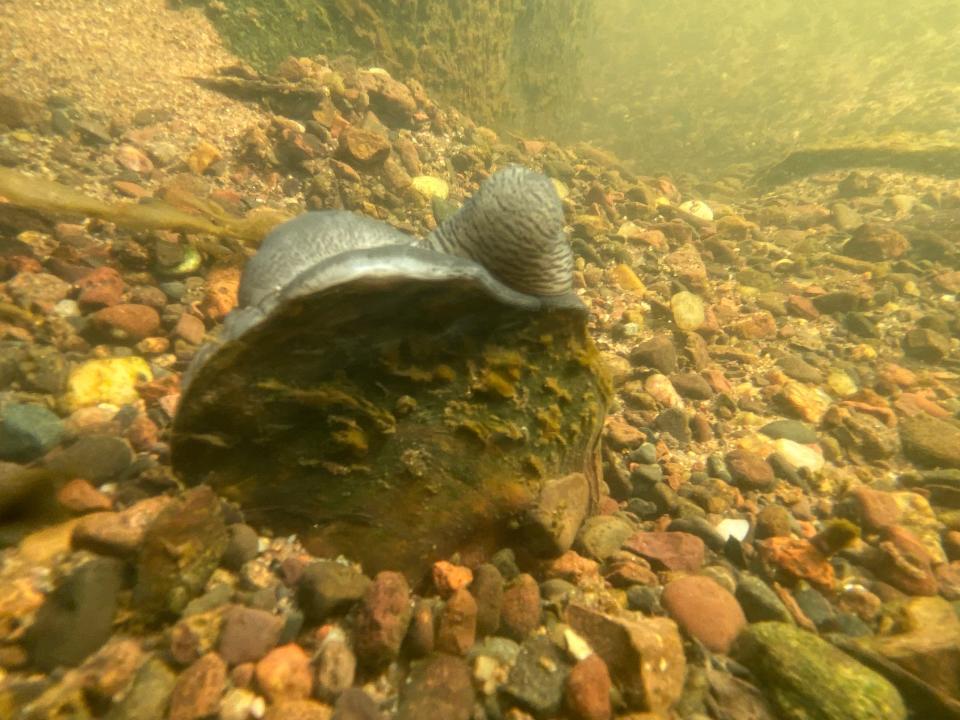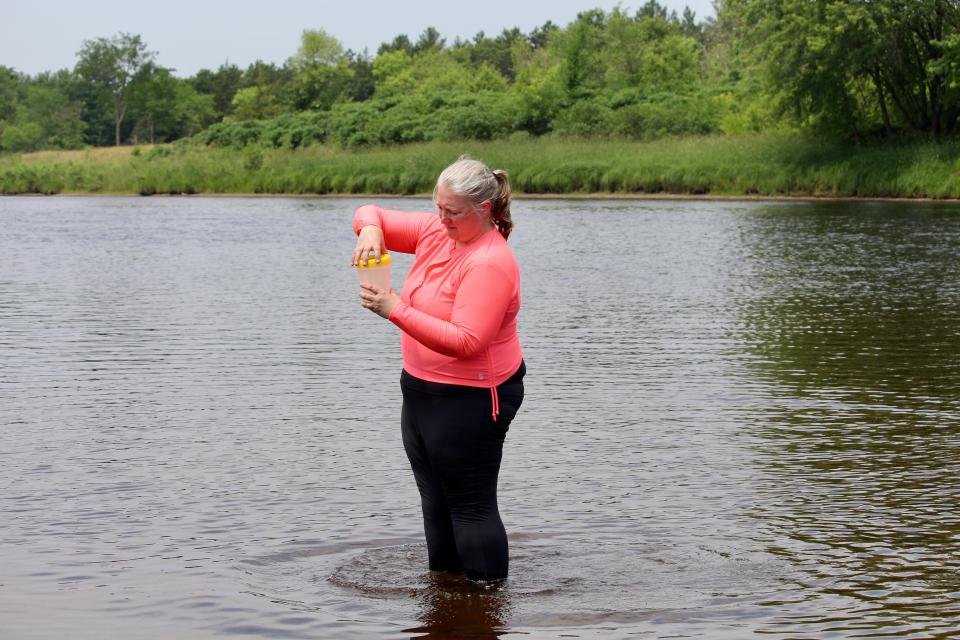In this western Wisconsin river, scientists see hope for saving endangered mussel species

MERIDEAN - Michelle Bartsch and Megan Bradley stood on the banks of the Chippewa River, holding onto precious cargo.
Enclosed in the containers in their hands on a recent June day were 3,500 juvenile winged mapleleaf mussels that had been surviving under the care of scientists since the spring. These animals, a species of freshwater mussel once found in rivers all across the central U.S., are now exceedingly rare.
Bartsch, a research biologist for the U.S. Geological Survey in La Crosse, and Bradley, a mussel biologist at the U.S. Fish and Wildlife Service's fish hatchery in Genoa, are leading an effort to help the mussels thrive again in their natural habitat.
Bradley and two of her colleagues swam to the other side of the river, where they poured the mussels through a PVC pipe to help the minuscule creatures — about half the size of a grain of salt — settle down into the river bottom. Back on shore, staff from the many environment agencies involved in the project clapped and cheered.
"Safe travels, babies," Bartsch called.
Imperiled freshwater mussels perform a crucial job
Mussels often get a bad rap — people are either too familiar with invasive zebra mussels wreaking havoc around the Great Lakes region, or simply uninterested. But freshwater mussels have a crucial job to do in the river ecosystem, filtering the water so it's clean and safe.
More: How invasive species changed the Great Lakes forever
Today, their important role is in jeopardy. Freshwater mussels are the most imperiled group of animals on the continent, with an estimated two-thirds of species at risk of extinction — including the winged mapleleaf.
The race to save this species isn't really a race at all. Since mussels can live for several decades, a scientist could spend her entire career working on restoration efforts. And there are still many mysteries to be unlocked about the survival of winged mapleleaf mussels in particular.
But the drop-off into the Chippewa represented an important milestone: if it's successful, it would prove the river as a safe place to help make the population strong again. That day, the gravity of the action was palpable.
"Sometimes I have to pinch myself to make sure it's a real thing," Bartsch said.
Freshwater mussels tell the tale of what's happened to America's rivers
It's pretty well acknowledged that mussels aren't the flashiest underwater creature. Much of the work they do improving habitat and water quality is behind the scenes, Bartsch said.
Nestled at the river bottom, they feed on bacteria, algae and other pollutants from the water above them, leaving it cleaner for their fellow river inhabitants as well as for human use, whether that be for recreation or drinking water. One mussel can filter several gallons of water per day.

Their function as natural water treatment plants is getting more attention these days. Philadelphia, for example, opened a city-owned mussel hatchery in 2017 with the goal of using the animals to clean up the Delaware River, from which the city draws drinking water.
While humans are now enlisting the help of mussels, we also played a role in their decline, though there are still questions to be answered about it. Winged mapleleaf mussels in particular are a sensitive species that require clear water and clean sediment at the bottom to survive. They used to be found in more than 40 rivers, including the Mississippi — but decades of industrial work, deforestation and pollution runoff, as well as the damming of the upper river, may have driven them out. In 1991, they were added to the federal endangered species list, where they remain today.

"Winged mapleleaf are a good story about all the long impacts we've had on our rivers," Bradley said.
Today, the U.S. has but a handful of populations of winged mapleleaf mussels. They're found in a few rivers in the south, and the St. Croix River near the Twin Cities is home to the only population in the upper Mississippi River basin that's been able to survive without human intervention.
More: See mayflies on the Mississippi? This citizen science program wants your help tracking them.
Bradley suspects their complex reproduction process is what's slowing restoration efforts. Once sperm from a male fertilizes the female's eggs, the developing larvae are thrust into the river current where they must attach to a specific species of fish to continue growing. For the winged mapleleaf mussels, that's either channel catfish or blue catfish.
So in order for the mussels to survive, the fish, too, need to be in the right place at the right time — making natural reproduction a real challenge.
Cleaner Chippewa River gives mussels a safe home
That's why for this project, the animals are getting some help.
Last fall, U.S. Geological Survey and U.S. Fish and Wildlife Service scientists, along with a number of other partners, injected winged mapleleaf mussel larvae onto 25 channel catfish — the host fish that the young mussels need to grow. In the spring, more than 112,000 young mussels were recovered from the fish.
The Geological Survey's Upper Midwest Environmental Science Center in La Crosse, the Fish and Wildlife Service, the Minnesota DNR and the Minnesota Zoo are holding on to most of them so they can safely keep growing larger.
In all, 12,000 were deposited into the Chippewa at the end of June, joining 150 adult winged mapleleaf mussels that were placed there in 2016. Those mussels are surviving, but the thousands of new ones will help broaden the genetic diversity of the population so it can be more robust and weather environmental changes, Bradley said.
In about five years, Bradley said, the young mussels will be marble-sized, able to be counted when scientists go out to survey the area. If they've survived, more could be added.

It was already suspected that the Chippewa might make a good home for these mussels. Another federally endangered mussel species, the sheepnose, is thriving there. And about 10,000 Higgins' Eye pearlymussels, which are also endangered, have been placed there since 2017.
Bradley said that's a testament to cleanup efforts on the river, whose basin was once soiled by mining and deforestation. In the long run, it could yield promising results: over the course of her career, she projected, this work could move the needle toward dropping these mussel species from "endangered" to a less dire status.
Still, it'll be a tall task. One of the requirements to downlist the species is that there are populations free from the risk of zebra mussels, which have already crept into the St. Croix River.
Given the intricacies of what they need to survive and the threats they face, some might wonder why it's so important to save one species of mussel.
For one, the loss of a single species is rarely contained to just that species, Bartsch said. Because scientists haven't yet uncovered all the benefits mussels provide to their underwater neighbors, losing these creatures would likely have ripple effects.
The winged mapleleaf mussel is both beautiful and strange, Bradley described, with an elephant trunk-like lure that waves to attract fish to pick up its larvae. Allowing that beauty and strangeness to disappear would be a failure in a larger sense, she said.
"North America has some of the highest diversity of freshwater mussels anywhere in the world, and not acting as good stewards of that resource would be such a pity," Bradley said, "to just write it off because we don't appreciate it."
A prior version of this story incorrectly stated Mondovi as the location of the drop-off. It occurred in Meridean, Wisconsin.
Madeline Heim is a Report for America corps reporter who writes about environmental issues in the Mississippi River watershed and across Wisconsin. Contact her at 920-996-7266 or mheim@gannett.com.
This article originally appeared on Milwaukee Journal Sentinel: Scientists restore endangered mussel species in western Wisconsin waters

